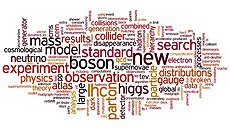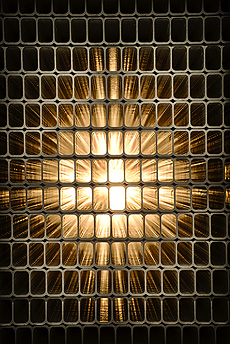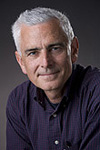Have a safe day!
Wednesday, May 15
3:30 p.m.
DIRECTOR'S COFFEE BREAK - 2nd Flr X-Over
4 p.m.
Fermilab Colloquium - One West
Speaker: Roger Blandford, Kavli Institute, Stanford University
Title: The Accelerating Universe
Thursday, May 16
2:30 p.m.
Theoretical Physics Seminar - Curia II
Speaker: Florian Goertz, ETH Zurich
Title: Higgs Boson Self-Coupling Measurements Using Ratios of Cross Sections
3:30 p.m.
DIRECTOR'S COFFEE BREAK - 2nd Flr X-Over
THERE WILL BE NO ACCELERATOR PHYSICS AND TECHNOLOGY SEMINAR TODAY
Click here for NALCAL,
a weekly calendar with links to additional information.
Ongoing and upcoming conferences at Fermilab
|
|
Wednesday, May 15
- Breakfast: crustless quiche casserole
- Breakfast: ham, egg and cheese English muffin
- Chicken cordon bleu sandwich
- Smart cuisine: beef burgundy ragout
- Roasted turkey
- Turkey bacon panini
- Blackened chicken alfredo
- Chunky broccoli cheese soup
- Texas-style chili
- Assorted calzones
Wilson Hall Cafe menu |
|
Wednesday, May 15
Lunch
- Ropa vieja (braised beef, peppers, onions)
- Yellow rice with toasted cumin
- Baked custard with rum sauce
Friday, May 17
Dinner
Closed
Chez Leon menu
Call x3524 to make your reservation.
|
|
The top 40 physics hits of 2012
 |
The Higgs boson is a popular subject among the most-cited physics papers of 2012, but a particle simulation manual takes the top spot.
|
Think of it as a particle physics version of pop radio's "top 40" countdown: INSPIRE, a database of particle-physics publications, has released its annual list of most-cited articles.
Topping the charts in 2012 are articles about the Higgs boson, which made up about 20 percent of the list.
But the most-cited publication of 2012 is a 583-page manual about PYTHIA, a program for simulating particle collisions and their byproducts. Researchers at Lund University in Sweden and Fermilab in the United States published the manual in 2006. The PYTHIA manual, which was cited in an estimated 1225 scientific articles in 2012, also ranked very high in INSPIRE's top-cited lists for 2011 and 2010.
INSPIRE, built and operated by a collaboration that includes CERN, the German laboratory DESY, Fermilab and SLAC, provides access to all high-energy physics papers and literature. Its predecessor, SPIRES-HEP, was a key driver in the early development and launch of the World Wide Web.
Heath O'Connell, a Fermilab information resources manager who helps oversee INSPIRE, says he's not surprised that the Higgs boson is one of the hottest topics on this year's list, appearing in both experimental and theoretical papers.
Based on the continuing attention to the Higgs discovery and the related ongoing research within the physics community, "certainly Higgs boson papers are going to rank very high up," he says. "They are [also] well within reach of the top position for the 2013 list."
Papers about neutrinos and antineutrinos, supernovae, dark matter and dark energy, as well as other particle simulation programs, also grabbed top spots on the INSPIRE list. (The word cloud above shows common words in the titles of the 2012 top 40 papers.)
Read more
—Glenn Roberts Jr.
|
Soon to scintillate
 |
These are just some of the 362,000 highly reflective plastic PVC tubes that will become part of NOvA's two detectors. Each of the cells will be filled with liquid scintillator. When a neutrino strikes an atom in the liquid scintillator, it will release a burst of photons. Photodetectors will sense the resulting pattern of lighted tubes. Scientists can then determine the kind of neutrino that caused the interaction. Each cell measures 3.9 cm wide, 6.0 cm deep and 15.5 m long. Photo: Reidar Hahn |
|
Hints of lightweight dark matter get even stronger
From Scientific American, May 10, 2013
A strange light is shining near the centre of the Milky Way, and evidence is mounting that it is the spark of lightweight dark matter meeting a violent end. At the same time, a suite of sensitive detectors deep underground is seeing hints of similar particles.
Dark matter is thought to make up roughly 80 per cent of the matter in the universe. But aside from its gravitational tug on regular matter, the substance has proven tough to detect, and many of its fundamental properties remain unknown.
The leading theoretical candidates for dark matter are weakly interacting massive particles (WIMPs). It's thought these particles annihilate when they meet, producing a shower of radiation, including gamma rays. Launched in 2008, NASA's Fermi space telescope has been scanning for excess gamma rays emanating from the centre of our galaxy, where dark matter should be concentrated.
Last year scientists ruled out a possible Fermi signal at 130 gigaelectronvolts (GeV) as dark matter's smoking gun. But there is another: In 2010, physicist Dan Hooper at Fermilab in Batavia, Illinois, and colleagues reported a possible hint from the space telescope of dark matter particles with a mass of about 10 GeV.
Read more |
'Einstein's planet': new alien world revealed by relativity
From Space.com, May 13, 2013
Einstein's special relativity has proven more useful than ever, as scientists have now used it to discover an alien planet around another star.
The newfound world—nicknamed "Einstein's planet" by the astronomers who discovered it—is the latest of more than 800 planets known to exist beyond our solar system, and the first to be found through this method.
Read more |
|
Cosmic background: from quantum to cosmos
 |
|
Craig Hogan
|
Craig Hogan, director of the Center for Particle Astrophysics, wrote this column.
The first great breakthrough of 20th-century physics came just as it dawned, in late 1900, when Max Planck derived from simple quantum principles an exact universal formula for the spectrum, or amount of light at each frequency, emitted by opaque matter.
A related breakthrough in cosmology came many decades later, when it was found that radiation with precisely Planck's spectrum is found not only in the laboratory, but also coming from all directions in the sky. This simple fact carries a profound message about cosmic history: The entire universe is expanding from a state when matter everywhere was once hot, dense and opaque. The cosmic radiation is left over from the earliest moments of the cosmic expansion—the big bang.
In recent decades, measurements have shown that the cosmic radiation is not at exactly just one temperature, but varies by a tiny amount in different directions—a little colder here, a little hotter there. The early universe was not perfectly uniform, which is a good thing, because those tiny variations eventually led to the formation of galaxies and, of course, us.
The rich complexity of cosmic structure now provides more things to measure than just a single temperature. Cosmological information today is so precise and diverse that it informs us about new physics, not just the other way around. The structure and evolution of the universe is measured in different ways—for example, with surveys of galaxies and maps of the background radiation. By comparing different probes, we learn about the physics that connects them as well the new physics that creates structure. Perhaps the most famous example is dark energy, a behavior of nature measured only by its effects on the largest scales.
Measurements of cosmic background radiation have advanced rapidly in the last year with new high-resolution detectors in Chile and at the South Pole and with the release in March of definitive all-sky data from the Planck satellite. Some of these results offer tantalizing hints of new physics beyond the Standard Model, and future data may provide a reliable independent way to measure particle properties, such as neutrino masses. The new data radically constrain models of inflation, the new physics that powered the start of the cosmic expansion and created its originally quantum fluctuations. Although many earlier flights of theorists' imaginations have now been permanently grounded, the paradigm of inflationary cosmology has been spectacularly confirmed.
Fermilab scientists invented many techniques of precision cosmology, helped create the Sloan Digital Sky Survey that defines the state of the art in precision measurement of cosmic structure with galaxies, and are about to start operating a still deeper cosmic mapping project, the Dark Energy Survey. Exciting choices lie ahead as we plan our participation in future experiments, perhaps including measurements of cosmic background radiation.
|
ESH&Q weekly report,
May 14
This week's safety report, compiled by the Fermilab ESH&Q section, contains five incidents.
An employee had a coworker remove a tick from his head while working outdoors. The Medical Office removed another tick the following morning. He received first-aid treatment.
An employee was stung on the arm by a bee. He received first-aid treatment.
An employee suffered a puncture laceration when the screwdriver he was using slipped and struck his left thumb. He received first-aid treatment.
An employee backed a vehicle into a pole in the parking lot. There were no injuries.
An employee experienced stinging eyes, stuffy nose and a taste of dirt after moving into his new office.
Find the full report here. |
|